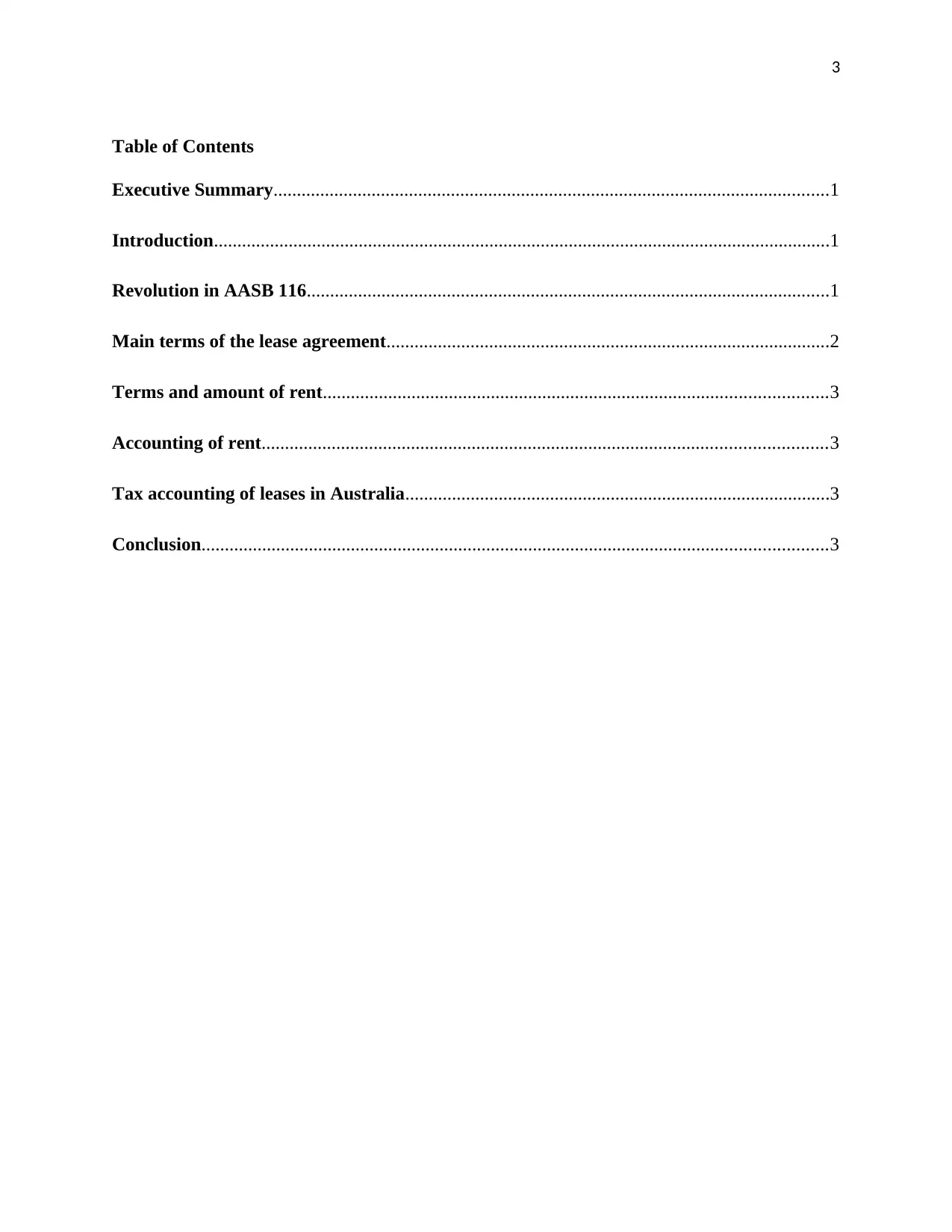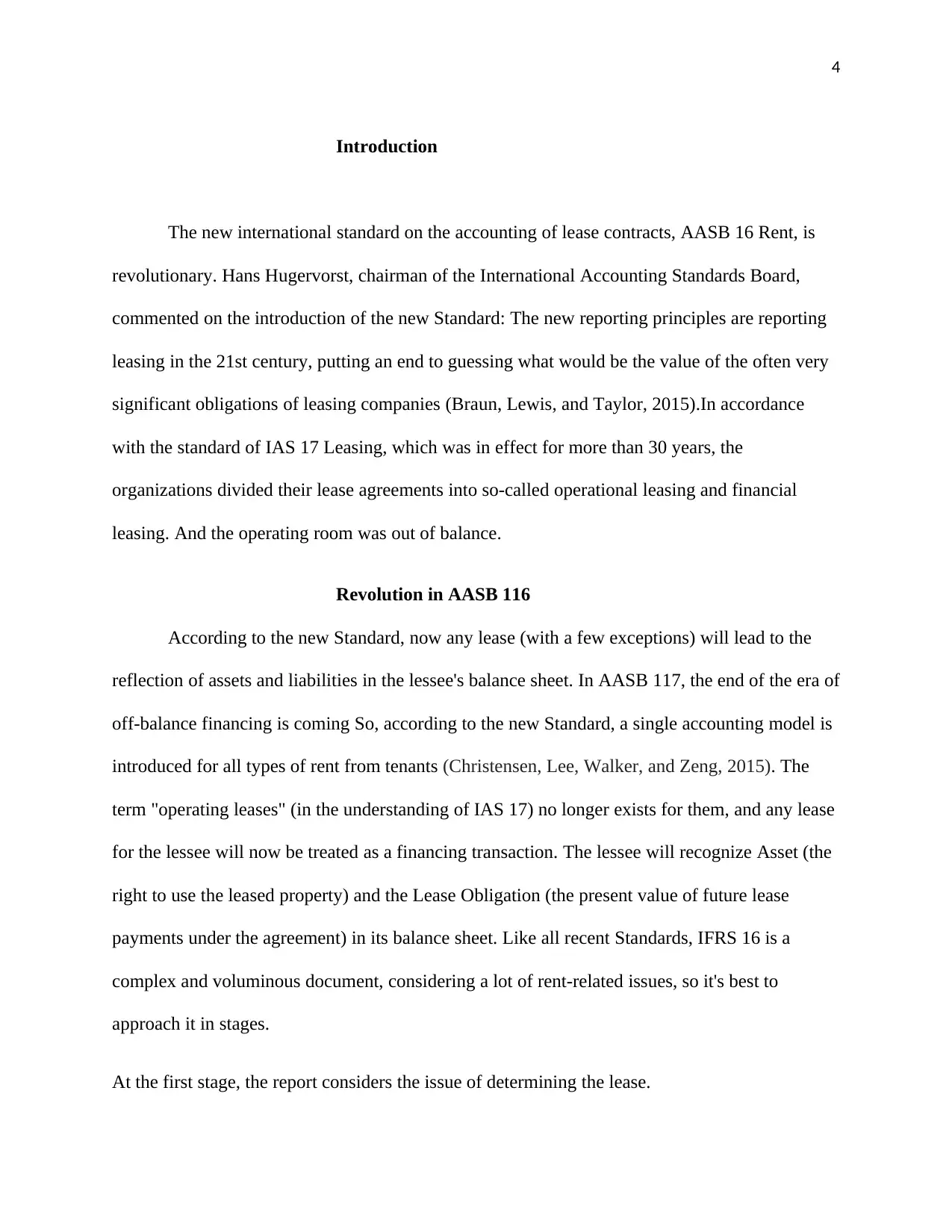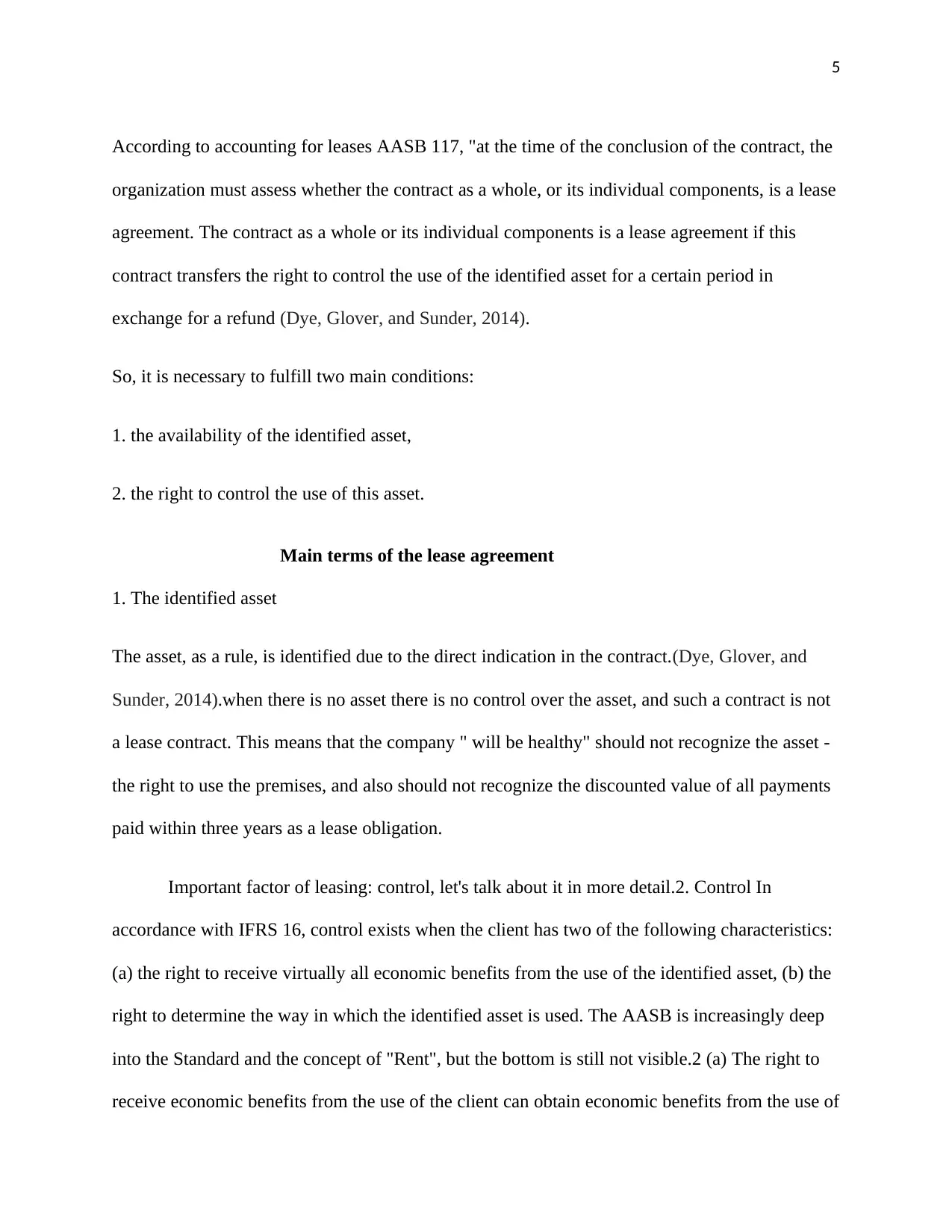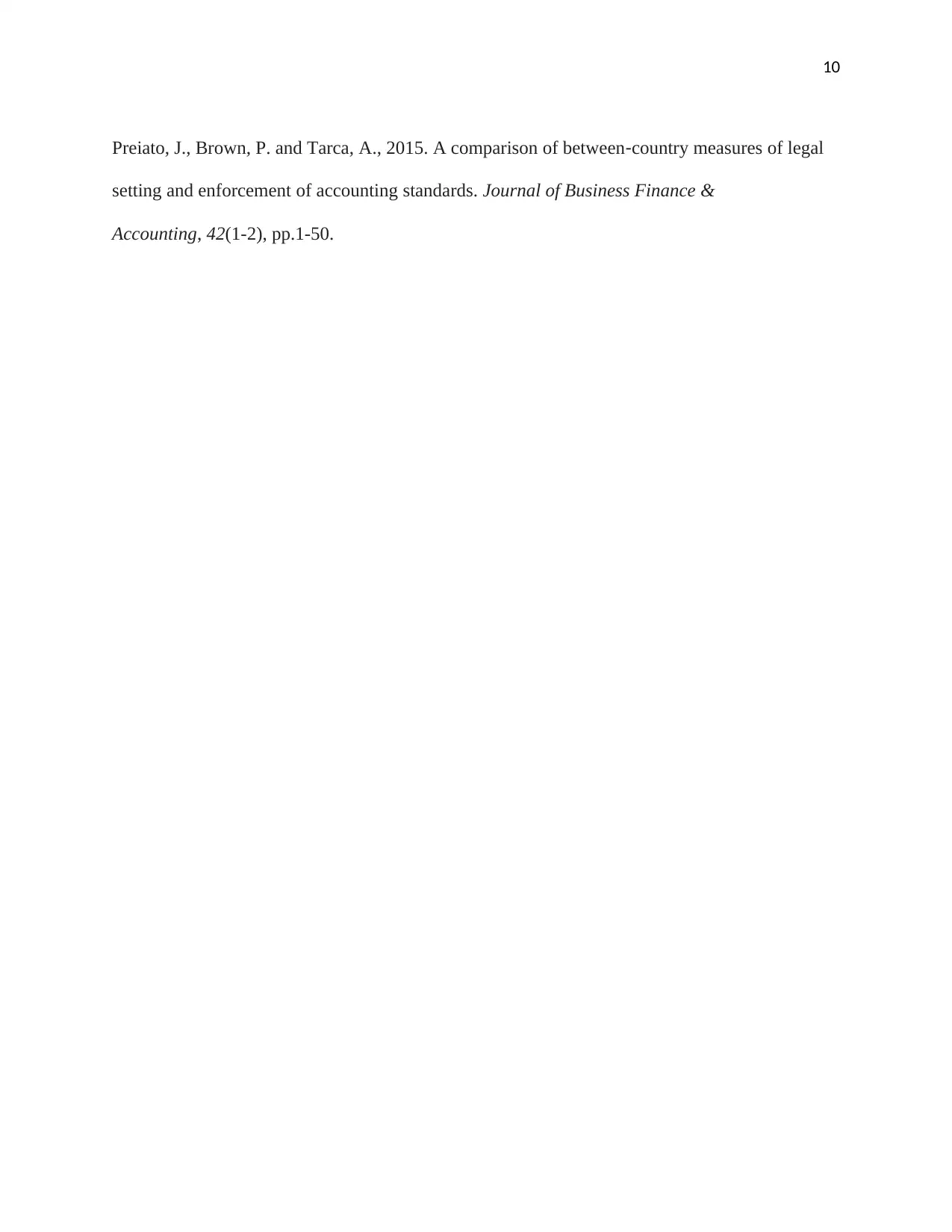MYR Ltd: AASB 16 Leases - Financial Statement & Economic Impact
VerifiedAdded on 2023/06/04
|10
|1957
|449
Report
AI Summary
This report assesses the impact of AASB 16 Leases on Myer Ltd (MYR), an ASX-listed retailer. It summarizes current accounting policies under AASB 117 and proposed policies under AASB 16 concerning leases of premises. The report details the potential effects of these changes on MYR's financial statements, including balance sheet and income statement impacts. Furthermore, it evaluates the potential economic consequences for MYR, utilizing relevant accounting theory to analyze the implications of the new standard on the company's financial reporting and business operations.

1
Accounting for Leases
Name:
Course
Professor’s name
University name
City, State
Date of submission
Accounting for Leases
Name:
Course
Professor’s name
University name
City, State
Date of submission
Paraphrase This Document
Need a fresh take? Get an instant paraphrase of this document with our AI Paraphraser

2
Executive Summary
Accounting policies and standards changes from time to time. Accounting for leases will
definitely change depending on the accounting policies and standards set by the AASB116 and
AASB 117. The leases are classified as either capital leases of operating leases by the AASB
116. In lease arrangements and agreements, the owner-lessor has an agreement to rent an asset to
the tenant lessee. The asset may be a machinery, building, land or equipment. The IASB has
estimated that about 85% of all leasing obligations of trade organizations using IFRS and US
GAAP are not reflected in the financial statements as liabilities of the organization. But these
obligations are quite real, and most of the creditors and rating agencies have always taken into
account the leasing obligations when assessing the financial condition of companies.
Executive Summary
Accounting policies and standards changes from time to time. Accounting for leases will
definitely change depending on the accounting policies and standards set by the AASB116 and
AASB 117. The leases are classified as either capital leases of operating leases by the AASB
116. In lease arrangements and agreements, the owner-lessor has an agreement to rent an asset to
the tenant lessee. The asset may be a machinery, building, land or equipment. The IASB has
estimated that about 85% of all leasing obligations of trade organizations using IFRS and US
GAAP are not reflected in the financial statements as liabilities of the organization. But these
obligations are quite real, and most of the creditors and rating agencies have always taken into
account the leasing obligations when assessing the financial condition of companies.

3
Table of Contents
Executive Summary.......................................................................................................................1
Introduction....................................................................................................................................1
Revolution in AASB 116................................................................................................................1
Main terms of the lease agreement...............................................................................................2
Terms and amount of rent............................................................................................................3
Accounting of rent.........................................................................................................................3
Tax accounting of leases in Australia...........................................................................................3
Conclusion......................................................................................................................................3
Table of Contents
Executive Summary.......................................................................................................................1
Introduction....................................................................................................................................1
Revolution in AASB 116................................................................................................................1
Main terms of the lease agreement...............................................................................................2
Terms and amount of rent............................................................................................................3
Accounting of rent.........................................................................................................................3
Tax accounting of leases in Australia...........................................................................................3
Conclusion......................................................................................................................................3
⊘ This is a preview!⊘
Do you want full access?
Subscribe today to unlock all pages.

Trusted by 1+ million students worldwide

4
Introduction
The new international standard on the accounting of lease contracts, AASB 16 Rent, is
revolutionary. Hans Hugervorst, chairman of the International Accounting Standards Board,
commented on the introduction of the new Standard: The new reporting principles are reporting
leasing in the 21st century, putting an end to guessing what would be the value of the often very
significant obligations of leasing companies (Braun, Lewis, and Taylor, 2015).In accordance
with the standard of IAS 17 Leasing, which was in effect for more than 30 years, the
organizations divided their lease agreements into so-called operational leasing and financial
leasing. And the operating room was out of balance.
Revolution in AASB 116
According to the new Standard, now any lease (with a few exceptions) will lead to the
reflection of assets and liabilities in the lessee's balance sheet. In AASB 117, the end of the era of
off-balance financing is coming So, according to the new Standard, a single accounting model is
introduced for all types of rent from tenants (Christensen, Lee, Walker, and Zeng, 2015). The
term "operating leases" (in the understanding of IAS 17) no longer exists for them, and any lease
for the lessee will now be treated as a financing transaction. The lessee will recognize Asset (the
right to use the leased property) and the Lease Obligation (the present value of future lease
payments under the agreement) in its balance sheet. Like all recent Standards, IFRS 16 is a
complex and voluminous document, considering a lot of rent-related issues, so it's best to
approach it in stages.
At the first stage, the report considers the issue of determining the lease.
Introduction
The new international standard on the accounting of lease contracts, AASB 16 Rent, is
revolutionary. Hans Hugervorst, chairman of the International Accounting Standards Board,
commented on the introduction of the new Standard: The new reporting principles are reporting
leasing in the 21st century, putting an end to guessing what would be the value of the often very
significant obligations of leasing companies (Braun, Lewis, and Taylor, 2015).In accordance
with the standard of IAS 17 Leasing, which was in effect for more than 30 years, the
organizations divided their lease agreements into so-called operational leasing and financial
leasing. And the operating room was out of balance.
Revolution in AASB 116
According to the new Standard, now any lease (with a few exceptions) will lead to the
reflection of assets and liabilities in the lessee's balance sheet. In AASB 117, the end of the era of
off-balance financing is coming So, according to the new Standard, a single accounting model is
introduced for all types of rent from tenants (Christensen, Lee, Walker, and Zeng, 2015). The
term "operating leases" (in the understanding of IAS 17) no longer exists for them, and any lease
for the lessee will now be treated as a financing transaction. The lessee will recognize Asset (the
right to use the leased property) and the Lease Obligation (the present value of future lease
payments under the agreement) in its balance sheet. Like all recent Standards, IFRS 16 is a
complex and voluminous document, considering a lot of rent-related issues, so it's best to
approach it in stages.
At the first stage, the report considers the issue of determining the lease.
Paraphrase This Document
Need a fresh take? Get an instant paraphrase of this document with our AI Paraphraser

5
According to accounting for leases AASB 117, "at the time of the conclusion of the contract, the
organization must assess whether the contract as a whole, or its individual components, is a lease
agreement. The contract as a whole or its individual components is a lease agreement if this
contract transfers the right to control the use of the identified asset for a certain period in
exchange for a refund (Dye, Glover, and Sunder, 2014).
So, it is necessary to fulfill two main conditions:
1. the availability of the identified asset,
2. the right to control the use of this asset.
Main terms of the lease agreement
1. The identified asset
The asset, as a rule, is identified due to the direct indication in the contract.(Dye, Glover, and
Sunder, 2014).when there is no asset there is no control over the asset, and such a contract is not
a lease contract. This means that the company " will be healthy" should not recognize the asset -
the right to use the premises, and also should not recognize the discounted value of all payments
paid within three years as a lease obligation.
Important factor of leasing: control, let's talk about it in more detail.2. Control In
accordance with IFRS 16, control exists when the client has two of the following characteristics:
(a) the right to receive virtually all economic benefits from the use of the identified asset, (b) the
right to determine the way in which the identified asset is used. The AASB is increasingly deep
into the Standard and the concept of "Rent", but the bottom is still not visible.2 (a) The right to
receive economic benefits from the use of the client can obtain economic benefits from the use of
According to accounting for leases AASB 117, "at the time of the conclusion of the contract, the
organization must assess whether the contract as a whole, or its individual components, is a lease
agreement. The contract as a whole or its individual components is a lease agreement if this
contract transfers the right to control the use of the identified asset for a certain period in
exchange for a refund (Dye, Glover, and Sunder, 2014).
So, it is necessary to fulfill two main conditions:
1. the availability of the identified asset,
2. the right to control the use of this asset.
Main terms of the lease agreement
1. The identified asset
The asset, as a rule, is identified due to the direct indication in the contract.(Dye, Glover, and
Sunder, 2014).when there is no asset there is no control over the asset, and such a contract is not
a lease contract. This means that the company " will be healthy" should not recognize the asset -
the right to use the premises, and also should not recognize the discounted value of all payments
paid within three years as a lease obligation.
Important factor of leasing: control, let's talk about it in more detail.2. Control In
accordance with IFRS 16, control exists when the client has two of the following characteristics:
(a) the right to receive virtually all economic benefits from the use of the identified asset, (b) the
right to determine the way in which the identified asset is used. The AASB is increasingly deep
into the Standard and the concept of "Rent", but the bottom is still not visible.2 (a) The right to
receive economic benefits from the use of the client can obtain economic benefits from the use of

6
the asset directly or indirectly different for example: by using the asset, by holding the asset or
by subletting it. In this case, the contract may provide for certain restrictions, for example:
specify the maximum amount of use of the asset, limit the place or time of use of the asset by the
client, require the client to adhere to a certain practice of exploitation (Koen, 2015). This
conditions do not prevent the client from having the right to determine how the asset is used;
these are the so-called "rights of interest" of the supplier (lessor).
The decision to use a freight contract for the transport of goods or for storage, the
decision on the range of products sold in the trading areas. Well, we considered one of the many
issues of the new Rent Standard. True, until we paid due attention to the importance of the
correct definition of the "period lease ", in the evaluation of which it is necessary to take into
account the provided options for the extension or for the termination of the lease (provided there
is sufficient confidence that the options will lead to a change in the contractual lease period.
In the process of the lease of non-residential premises, there are sometimes situations in
which it is necessary to terminate the concluded agreement (Kwanti, 2018). The result of such
termination is in fact the termination of the lease of the premises and the release of the rented
premises by the lessee with the full return of all the things and valuables provided in it by the
lessee for the period of use.
Terms and amount of rent
When determining the conditions and amount of rent, the parties often allow the
following errors in the contract: To carry out entrepreneurial activities of the company, premises
are necessary. It can be either in property or in rent. The most common is the second option,
the asset directly or indirectly different for example: by using the asset, by holding the asset or
by subletting it. In this case, the contract may provide for certain restrictions, for example:
specify the maximum amount of use of the asset, limit the place or time of use of the asset by the
client, require the client to adhere to a certain practice of exploitation (Koen, 2015). This
conditions do not prevent the client from having the right to determine how the asset is used;
these are the so-called "rights of interest" of the supplier (lessor).
The decision to use a freight contract for the transport of goods or for storage, the
decision on the range of products sold in the trading areas. Well, we considered one of the many
issues of the new Rent Standard. True, until we paid due attention to the importance of the
correct definition of the "period lease ", in the evaluation of which it is necessary to take into
account the provided options for the extension or for the termination of the lease (provided there
is sufficient confidence that the options will lead to a change in the contractual lease period.
In the process of the lease of non-residential premises, there are sometimes situations in
which it is necessary to terminate the concluded agreement (Kwanti, 2018). The result of such
termination is in fact the termination of the lease of the premises and the release of the rented
premises by the lessee with the full return of all the things and valuables provided in it by the
lessee for the period of use.
Terms and amount of rent
When determining the conditions and amount of rent, the parties often allow the
following errors in the contract: To carry out entrepreneurial activities of the company, premises
are necessary. It can be either in property or in rent. The most common is the second option,
⊘ This is a preview!⊘
Do you want full access?
Subscribe today to unlock all pages.

Trusted by 1+ million students worldwide

7
since not all entrepreneurs can afford to purchase a room. Rent involves the emergence of
constant spending. They need to be properly taken into account.
Accounting of rent
To fix the cost of renting non-residential premises, the off-balance account 001 "Leased
OS" is used. Accounted for the cost of housing, prescribed in the contract. The costs are reflected
at the time of actual receipt of the premises. These rules are set by the Instruction on the use of
the Plan of Accounts, established by the Order of the IAAS.
Potential Impact of change in accounting standard
Classification as a capital and operating lease will dictae fundamentally the measurement and
recognition of cash flows and expenses associated with the said leases. There will be more
transparency and accountabilityof leased and lease related materials. CPAs will be faced with
considerations of making better decisions related to leases and resulting financial presentations.
It will affect ratio analysis in presentation of fianancial results.
Lease payments are considered to be other expenses directed at production and sale. The
corresponding instruction is given in clause 1 of Article 264 of the Tax Code (Laux, and
Stocken, 2018). The entrepreneur needs to remember that costs can be recognized as expenses
corresponding to these characteristics: The Tax Code does not contain a list of securities that
confirm the fact of the lease (Mügge, and Stellinga, 2015).
Potential economic consequences for MYR of the changes in accounting standards
Lease costs, according to clauses 5 and 7 of the Accounting Regulation established by the
IAASB, are considered as expenses in the main areas of activity. Monthly charges on leasing are
since not all entrepreneurs can afford to purchase a room. Rent involves the emergence of
constant spending. They need to be properly taken into account.
Accounting of rent
To fix the cost of renting non-residential premises, the off-balance account 001 "Leased
OS" is used. Accounted for the cost of housing, prescribed in the contract. The costs are reflected
at the time of actual receipt of the premises. These rules are set by the Instruction on the use of
the Plan of Accounts, established by the Order of the IAAS.
Potential Impact of change in accounting standard
Classification as a capital and operating lease will dictae fundamentally the measurement and
recognition of cash flows and expenses associated with the said leases. There will be more
transparency and accountabilityof leased and lease related materials. CPAs will be faced with
considerations of making better decisions related to leases and resulting financial presentations.
It will affect ratio analysis in presentation of fianancial results.
Lease payments are considered to be other expenses directed at production and sale. The
corresponding instruction is given in clause 1 of Article 264 of the Tax Code (Laux, and
Stocken, 2018). The entrepreneur needs to remember that costs can be recognized as expenses
corresponding to these characteristics: The Tax Code does not contain a list of securities that
confirm the fact of the lease (Mügge, and Stellinga, 2015).
Potential economic consequences for MYR of the changes in accounting standards
Lease costs, according to clauses 5 and 7 of the Accounting Regulation established by the
IAASB, are considered as expenses in the main areas of activity. Monthly charges on leasing are
Paraphrase This Document
Need a fresh take? Get an instant paraphrase of this document with our AI Paraphraser

8
reflected in the account 20 of the "Main Production" and the CT account "Settlements with
creditors. When the payment is transferred to the lessor, you need to make a record on the DT
account 76 and the CT account 51. As part of tax accounting, transfer of real estate for rent is
considered a service on the basis of the Tax Code (Preiato, Brown, and Tarca, 2015). The VAT
charged to the company is deductible at the time the rental service is taken into account.
Expenses for payment of utilities (including VAT) will be taken into account in the structure of
expenditure in the main areas of the company. They are recognized when receiving receipts from
the person providing the rental service.
reflected in the account 20 of the "Main Production" and the CT account "Settlements with
creditors. When the payment is transferred to the lessor, you need to make a record on the DT
account 76 and the CT account 51. As part of tax accounting, transfer of real estate for rent is
considered a service on the basis of the Tax Code (Preiato, Brown, and Tarca, 2015). The VAT
charged to the company is deductible at the time the rental service is taken into account.
Expenses for payment of utilities (including VAT) will be taken into account in the structure of
expenditure in the main areas of the company. They are recognized when receiving receipts from
the person providing the rental service.

9
References
Braun, G.P., Haynes, C.M., Lewis, T.D. and Taylor, M.H., 2015. Principles-based vs. rules-
based accounting standards: The effects of auditee proposed accounting treatment and regulatory
enforcement on auditor judgments and confidence. Research in Accounting Regulation, 27(1),
pp.45-50.
Christensen, H.B., Lee, E., Walker, M. and Zeng, C., 2015. Incentives or standards: What
determines accounting quality changes around IFRS adoption?. European Accounting
Review, 24(1), pp.31-61.
Dye, R., Glover, J. and Sunder, S., 2014. How Can Financial Reporting Standards Resist
Accounting-Motivated Financial Engineering?.
Koen, R., 2015. Evaluating the impact of changes in accounting standards: the South African
case (Doctoral dissertation, North-West University (South Africa), Potchefstroom Campus).
Kwanti, E., 2018. Accounting for Leases.
Laux, V. and Stocken, P.C., 2018. Accounting standards, regulatory enforcement, and
innovation. Journal of Accounting and Economics, 65(2-3), pp.221-236.
Mügge, D. and Stellinga, B., 2015. The unstable core of global finance: Contingent valuation and
governance of international accounting standards. Regulation & Governance, 9(1), pp.47-62.
References
Braun, G.P., Haynes, C.M., Lewis, T.D. and Taylor, M.H., 2015. Principles-based vs. rules-
based accounting standards: The effects of auditee proposed accounting treatment and regulatory
enforcement on auditor judgments and confidence. Research in Accounting Regulation, 27(1),
pp.45-50.
Christensen, H.B., Lee, E., Walker, M. and Zeng, C., 2015. Incentives or standards: What
determines accounting quality changes around IFRS adoption?. European Accounting
Review, 24(1), pp.31-61.
Dye, R., Glover, J. and Sunder, S., 2014. How Can Financial Reporting Standards Resist
Accounting-Motivated Financial Engineering?.
Koen, R., 2015. Evaluating the impact of changes in accounting standards: the South African
case (Doctoral dissertation, North-West University (South Africa), Potchefstroom Campus).
Kwanti, E., 2018. Accounting for Leases.
Laux, V. and Stocken, P.C., 2018. Accounting standards, regulatory enforcement, and
innovation. Journal of Accounting and Economics, 65(2-3), pp.221-236.
Mügge, D. and Stellinga, B., 2015. The unstable core of global finance: Contingent valuation and
governance of international accounting standards. Regulation & Governance, 9(1), pp.47-62.
⊘ This is a preview!⊘
Do you want full access?
Subscribe today to unlock all pages.

Trusted by 1+ million students worldwide

10
Preiato, J., Brown, P. and Tarca, A., 2015. A comparison of between‐country measures of legal
setting and enforcement of accounting standards. Journal of Business Finance &
Accounting, 42(1-2), pp.1-50.
Preiato, J., Brown, P. and Tarca, A., 2015. A comparison of between‐country measures of legal
setting and enforcement of accounting standards. Journal of Business Finance &
Accounting, 42(1-2), pp.1-50.
1 out of 10
Related Documents
Your All-in-One AI-Powered Toolkit for Academic Success.
+13062052269
info@desklib.com
Available 24*7 on WhatsApp / Email
![[object Object]](/_next/static/media/star-bottom.7253800d.svg)
Unlock your academic potential
Copyright © 2020–2025 A2Z Services. All Rights Reserved. Developed and managed by ZUCOL.





